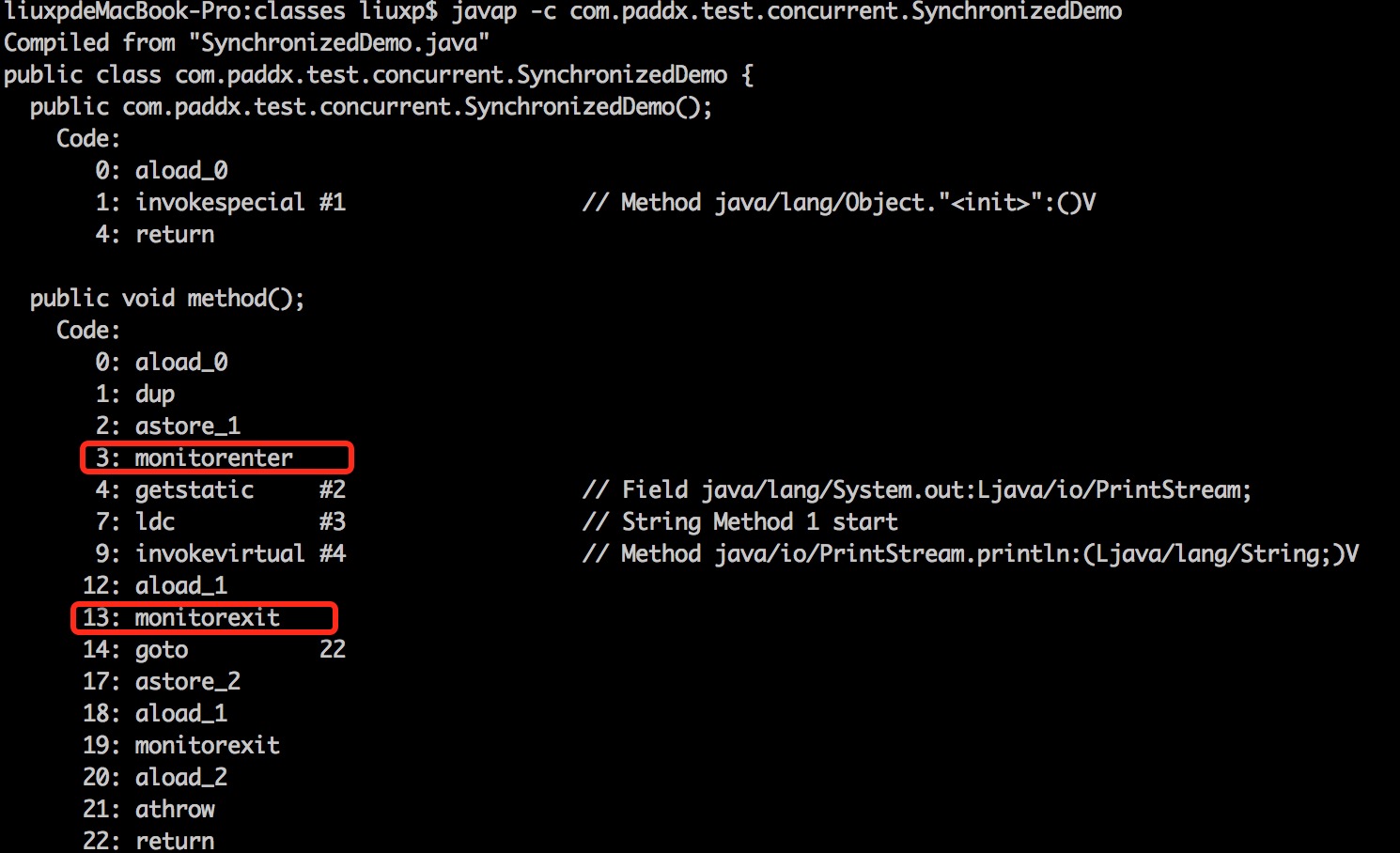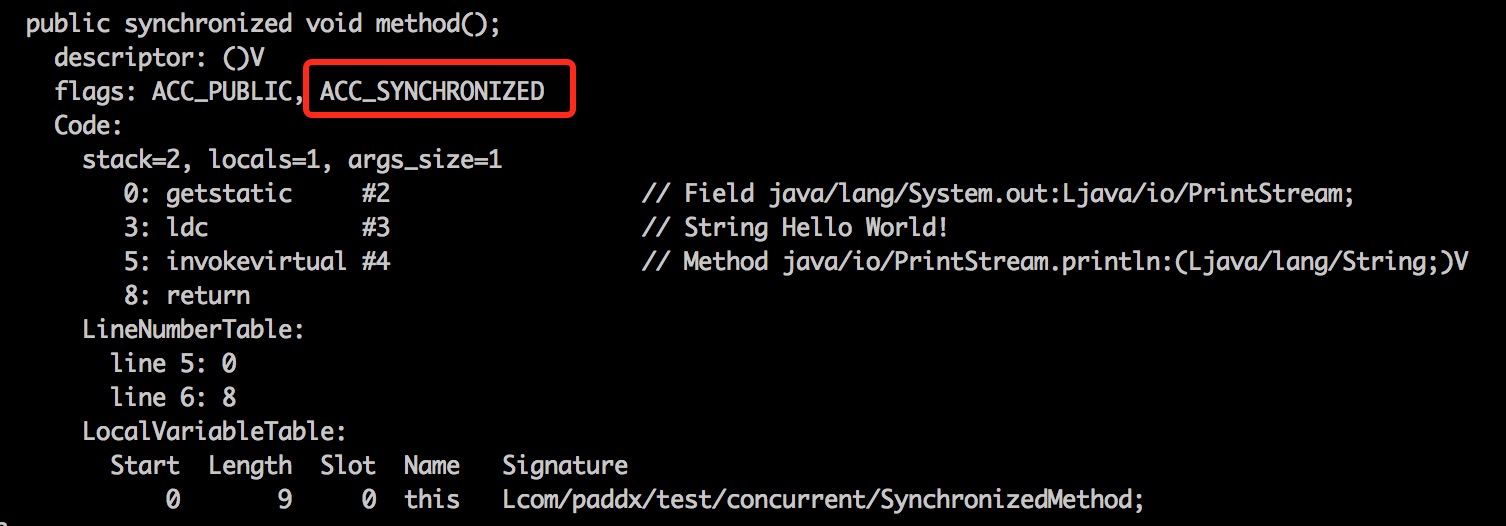synchronized是Java語言的關鍵字,當它用來修飾一個方法或者一個代碼塊的時候,能夠保證在同一時刻最多只有一個線程執行該段代碼。本文給大家介紹java中的用法。
一、為什么要使用synchronized
在并發編程中存在線程安全問題,主要原因有:
1.存在共享數據
2.多線程共同操作共享數據。
關鍵字synchronized可以保證在同一時刻,只有一個線程可以執行某個方法或某個代碼塊,同時synchronized可以保證一個線程的變化可見(可見性),即可以代替volatile。
synchronized可以保證方法或者代碼塊在運行時,同一時刻只有一個方法可以進入到臨界區,同時它還可以保證共享變量的內存可見性
二、synchronized的用法
synchronized可以修飾靜態方法、成員函數,同時還可以直接定義代碼塊,但是歸根結底它上鎖的資源只有兩類:一個是對象,一個是類。
- 修飾普通方法(實例方法),鎖是當前實例對象 ,進入同步代碼前要獲得當前實例的鎖
- 修飾靜態方法,鎖是當前類的class對象 ,進入同步代碼前要獲得當前類對象的鎖
- 修飾方法塊,鎖是括號里面的對象,對給定對象加鎖,進入同步代碼庫前要獲得給定對象的鎖。
三、實現原理
我們先通過反編譯下面的代碼來看看Synchronized是如何實現對代碼塊進行同步的:
package com.paddx.test.concurrent;public class SynchronizedDemo {public void method() {synchronized (this) {System.out.println("Method 1 start");}}}
反編譯結果:

關于這兩條指令的作用,我們直接參考JVM規范中描述:
monitorenter :
Each object is associated with a monitor. A monitor is locked if and only if it has an owner. The thread that executes monitorenter attempts to gain ownership of the monitor associated with objectref, as follows:
? If the entry count of the monitor associated with objectref is zero, the thread enters the monitor and sets its entry count to one. The thread is then the owner of the monitor.
? If the thread already owns the monitor associated with objectref, it reenters the monitor, incrementing its entry count.
? If another thread already owns the monitor associated with objectref, the thread blocks until the monitor’s entry count is zero, then tries again to gain ownership.
這段話的大概意思為:
每個對象有一個監視器鎖(monitor)。當monitor被占用時就會處于鎖定狀態,線程執行monitorenter指令時嘗試獲取monitor的所有權,過程如下:
1、如果monitor的進入數為0,則該線程進入monitor,然后將進入數設置為1,該線程即為monitor的所有者。
2、如果線程已經占有該monitor,只是重新進入,則進入monitor的進入數加1.
3.如果其他線程已經占用了monitor,則該線程進入阻塞狀態,直到monitor的進入數為0,再重新嘗試獲取monitor的所有權。
monitorexit:
The thread that executes monitorexit must be the owner of the monitor associated with the instance referenced by objectref.
The thread decrements the entry count of the monitor associated with objectref. If as a result the value of the entry count is zero, the thread exits the monitor and is no longer its owner. Other threads that are blocking to enter the monitor are allowed to attempt to do so.
這段話的大概意思為:
執行monitorexit的線程必須是objectref所對應的monitor的所有者。
指令執行時,monitor的進入數減1,如果減1后進入數為0,那線程退出monitor,不再是這個monitor的所有者。其他被這個monitor阻塞的線程可以嘗試去獲取這個 monitor 的所有權。
通過這兩段描述,我們應該能很清楚的看出Synchronized的實現原理,Synchronized的語義底層是通過一個monitor的對象來完成,其實wait/notify等方法也依賴于monitor對象,這就是為什么只有在同步的塊或者方法中才能調用wait/notify等方法,否則會拋出java.lang.IllegalMonitorStateException的異常的原因。
我們再來看一下同步方法的反編譯結果:
源代碼:
1 package com.paddx.test.concurrent;
2
3 public class SynchronizedMethod {
4 public synchronized void method() {
5 System.out.println("Hello World!");
6 }
7 }
反編譯結果:

從反編譯的結果來看,方法的同步并沒有通過指令monitorenter和monitorexit來完成(理論上其實也可以通過這兩條指令來實現),不過相對于普通方法,其常量池中多了ACC_SYNCHRONIZED標示符。JVM就是根據該標示符來實現方法的同步的:當方法調用時,調用指令將會檢查方法的 ACC_SYNCHRONIZED 訪問標志是否被設置,如果設置了,執行線程將先獲取monitor,獲取成功之后才能執行方法體,方法執行完后再釋放monitor。在方法執行期間,其他任何線程都無法再獲得同一個monitor對象。 其實本質上沒有區別,只是方法的同步是一種隱式的方式來實現,無需通過字節碼來完成。
四、總結
Synchronized是Java并發編程中最常用的用于保證線程安全的方式,其使用相對也比較簡單。但是如果能夠深入了解其原理,對監視器鎖等底層知識有所了解,一方面可以幫助我們正確的使用Synchronized關鍵字,另一方面也能夠幫助我們更好的理解并發編程機制,有助我們在不同的情況下選擇更優的并發策略來完成任務。



















